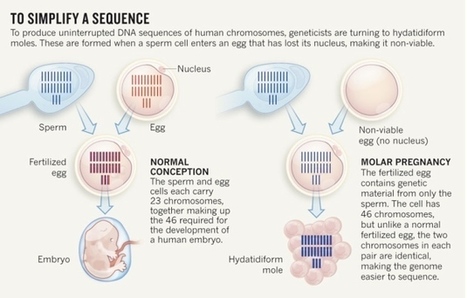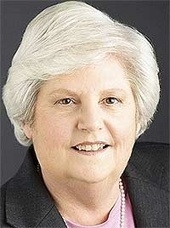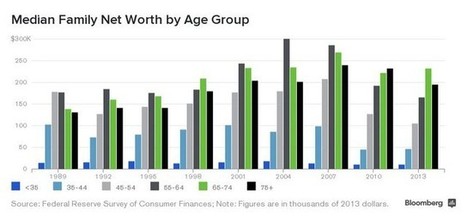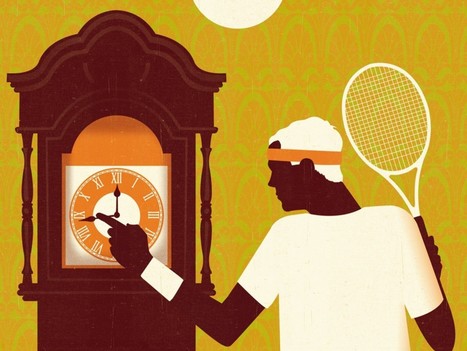 Your new post is loading...

|
Scooped by
Linda Holroyd
November 19, 2014 6:06 PM
|
Geneticists have a dirty little secret. More than a decade after the official completion of the Human Genome Project, and despite the publication of multiple updates, the sequence still has hundreds of gaps — many in regions linked to disease. Now, several research efforts are closing in on a truly complete human genome sequence, called the platinum genome.
“It’s like mapping Europe and somebody says, ‘Oh, there’s Norway. I really don’t want to have to do the fjords’,” says Ewan Birney, a computational biologist at the European Bioinformatics Institute near Cambridge, UK, who was involved in the Human Genome Project. “Now somebody’s in there and mapping the fjords.”
Landing on a comet: A guide to Rosetta’s perilous mission
Italian seismologists cleared of manslaughter
Edits to ethics code rankle
The efforts, which rely on the DNA from peculiar cellular growths, are uncovering DNA sequences not found in the official human genome sequence that have potential links to conditions such as autism and the neuro-degenerative disease amyotrophic lateral sclerosis (ALS).
In 2000, then US President Bill Clinton joined leading scientists to unveil a draft human genome. Three years later, the project was declared finished. But there were caveats: that human ‘reference’ genome was more than 99% complete, but researchers could not get to 100% because of method limitations.
Sequencing machines cannot process entire chromosomes, so scientists must first make many identical copies of the DNA and cut them into short stretches, with the breaks in different places. After sequencing, a computer program looks for overlapping patterns to ‘stitch’ the resulting segments back together.
This approach worked for most of the genome, because DNA sequences are almost identical across its three billion ‘letters’ (the As, Cs, Ts and Gs). But in some parts, big differences exist between the versions of chromosomes that an individual inherits from the mother and father. Attempts to stitch together these regions to sequence the DNA led to gaps when the differing sequences gave conflicting solutions.
“There’s a whole level of genetic variation that we’re missing.”
The problem can be likened to assembling a single jigsaw puzzle from the mixed-up pieces of similar, but not identical, puzzles. If one puzzle piece is identical across the sets, any copy of it will do. But if one set contains a much larger version of the matching piece, or if a piece is missing, the puzzle will not fit together. In particular, long, repetitive stretches near genes vexed the computer algorithms used to analyse the data. And the problem was made worse because DNA from multiple people was used, adding to the variation between the genomes.
As a result, when a person’s genome is sequenced — for instance, to look for the cause of a disease — crucial bits of DNA may be overlooked because they do not have counter-parts in the published genome. “There’s a whole level of genetic variation that we’re missing,” says Evan Eichler, a genome scientist at the University of Washington in Seattle, a leading proponent of the platinum-genome efforts. To plug the gaps, researchers need a supply of human cells with just a single version of each chromosome, to remove the possibility of conflicting solutions — a single set of puzzle pieces, in other words.
Sperm and egg cells contain a single copy of each chromosome, but these cells cannot divide and produce copies of themselves. So in recent years, geneticists have turned to cells from growths called hydatidiform moles, created when a sperm fertilizes an egg that is missing its own genetic material (see ‘To simplify a sequence’). The fertilized cell copies its genome and starts dividing, just as the cells in a normal fertilized egg would. The resulting ball of cells, which is usually removed in the first trimester of pregnancy, contains identical copies of each human chromosome.
Expand
Cells taken from one such mole were used in the early 1990s to create a cell line called CHM1. In a Nature paper published on 10 November, Eichler and his colleagues describe how they used sections of the CHM1 genome to fill about 50 especially troublesome holes in the official human genome sequence. They also shortened many more gaps, including in genes linked to ALS and Fragile X syndrome, a neuro-developmental disease with autism-like symptoms (M. J. P. Chaisson et al. Nature http://doi.org/w69; 2014). In total, the team mapped around 1 million DNA letters that were missing in the original reference genome.
A true platinum sequence will be assembled from just one genome, however, because only then can scientists be sure there are no remaining gaps. To this end, a team led by Richard Wilson at Washington University in St. Louis, Missouri, reported a draft sequence of the entire CHM1 genome earlier this month (K. M. Steinberg et al. Genome Res. http://doi.org/w7b; 2014). Researchers at the firm Pacific Biosciences in Menlo Park, California, are similarly working on the whole CHM1 genome, but are using sequencers that work with longer stretches of uninterrupted DNA, and so produce fewer gaps than typical sequencers. The firm released a draft genome assembly in February. The hope is that the method will speed up the platinum genome’s arrival.
“The chances of actually achieving this, for one genome, are looking much better”, says Deanna Church, a genome scientist at the firm Personalis in Menlo Park. Still, Birney says that the human reference genome is more about “constant improvement” than completion. “For sure, somebody’s going to be fiddling around with this in 10–20 years’ time.”

|
Scooped by
Linda Holroyd
November 12, 2014 12:08 PM
|
As the country grays, too many people view older Americans as a drain on society, health care and public programs such as Medicare and Social Security, says AARP’s top lobbyist in Washington.
In reality, today’s seniors are healthier, wealthier and more diverse than ever, said Nancy LeaMond, executive vice president of AARP’s state and national group.
By 2030, 1 in 4 Americans will be older than 50, and the 65-and-older population will double, to 72 million, she said. In Ohio, 1 in 5 residents will be 65-plus by 2030.
There even will be a day — Jan. 1, 2042 — when 77 million baby boomers (those born between 1946 and 1964) and 82 million millennials (also known as Generation Y and loosely defined as those born between 1982 and 1999) will be receiving Social Security checks at the same time, she said.
“In a nutshell, our country, our states and our towns will be older in perpetuity.”
LeaMond was in Columbus to meet with AARP volunteers from across the state at a gathering to celebrate their accomplishments over the past year and to plan their priorities for the years ahead.
The growing population of older workers and retirees represents a transformative force, expected to account for more than half of the U.S. gross domestic product by 2032, she said. More seniors also are working longer and giving back by volunteering.
“Today, most people who make it to 65 will live roughly 20 years beyond traditional retirement age, meaning we have a new life stage that didn’t exist before,” she said.
Current older Americans also have a collective economic impact that surpasses every generation before them, LeaMond said.
Enter the “longevity economy” — the sum of all economic activity serving the needs of Americans older than 50, including the products and services they buy and the financial benefits that their spending generates.
When asked about the growing financial burden of Ohio’s aging population, Ohio Department of Aging Director Bonnie K. Burman said she likes to say, “We don’t have an aging problem; we have 2.3 million aging successes.”
Death rates are falling, and Americans are living longer because of public-health advancements, she said. People need to view that as a positive development — no matter how it impacts local, state and national budgets.
Ohio is focused on helping residents 60 and older “grow, thrive and contribute” throughout their golden years — and it appears that many are heeding the call, she said.
Contrary to popularly held assumptions, the highest rate of entrepreneurial activity over the past decade or so belongs to the 55-to-64 age group — not 20-somethings, as many would think given the dot.com boom, according to a report by the Marion Ewing Kauffman Foundation.
“The declinist view of aging has left the building,” Burman said.
In total, people 50 and older account for $3.1 trillion in consumer spending and $1.6 trillion in health-care spending, and they make up 80 percent of consumer net worth, according to a report by Oxford Economics and AARP released in January.
The average wealth of households headed by people older than 50 is nearly $765,000, compared with $225,000 for those headed by 25- to 50-year-olds, the report found.
“They’re a formidable force,” said Clint Eastman, a demographer and economist in Washington who studies the aging population.
Yet, this huge market is in many ways untapped, and the priorities of this massive population are often unaddressed by businesses, educators and public-policymakers, Eastman said.
Still, many people will experience a disability or declining health in their later years, and the state and country must be prepared, especially because most seniors aren’t saving enough money for their growing retirement years, LeaMond said.
“The sheer numbers of boomers heading into their 60s, 70s and 80s will present challenges to Social Security, Medicare and Medicaid — programs that are central to the health and retirement security of millions of older Americans,” she said.
And the oldest of the old — generally people who are 90 or older — will have the farthest-reaching implications.
“Yes, there are significant challenges,” LeaMond said. “But there is also tremendous opportunity.”

|
Rescooped by
Linda Holroyd
from Amazing Science
November 12, 2014 12:01 PM
|
A new study indicates that scientists have found a new way of delaying the aging process in mice, and they hope to replicate the finding in people.
The scientists published their findings in the journal Cell Metabolism¹. The research was built upon an earlier study that shed light on progeria, a rare genetic disease that prematurely ages one in four million babies.
A mutation was found in the Lamin A protein, which lines the nucleus in human cells, disrupting the repair process and accelerating aging. They also found that normal and healthy Lamin A binds to and activates the gene SIRT1, which has been long associated with longevity. If scientists can develop drugs that mimic Lamin A or increase the binding between Lamin A and SIRT1, this may lead to anti-aging drugs.
The team also examined if the binding efficiency was boosted with resveratrol, a compound found in the skin of red grapes. Mice fed with concentrated resveratrol fared significantly better than healthy mice that weren’t given it and the onset of aging was delayed and the life expectancy was extended. Mice with progeria lived 30% longer when fed with resveratrol compared with progerial mice not given the compound.
References
Liu, B. et al. C. Metabolism, Volume 16, Issue 6, 738-750 (2012), doi: 10.1016/j.cmet.2012.11.007.
Via Dr. Stefan Gruenwald

|
Scooped by
Linda Holroyd
November 12, 2014 11:50 AM
|
Jon Burkhart was born during the Great Depression. Like many of the so-called Silent Generation, he couldn’t have been more fortunate.
When he and his wife married in 1959, they lived in Texas and saved 10 percent of every paycheck. Thanks to well-timed equity and property investments, the 81-year-old now lives a much different life than the elderly he knew as a child.
“We just invested the money very wisely, some in markets and some in real estate, and as a result we built up a nice little nest egg by the time we were ready to retire,” said Burkhart, who lives at the Arbor Acres retirement community in Winston-Salem, North Carolina.
The median net worth for the oldest Americans has climbed to near the top compared with other age groups from near the bottom just two decades ago, based on the Federal Reserve’s Survey of Consumer Finances. This shift in buying power may not be a positive development for the economy as prime-age workers typically spend more than their elders.
The Silent Generation, born between 1928 and 1945, has benefited from improved health, a more generous social safety net, an exit from the job market ahead of the past recession and rebounding stock and home values. Combined with a diversified approach to investing, that’s made them “the richest old generation we’ve ever seen,” said William Emmons, a senior economic adviser at the Federal Reserve Bank of St. Louis. “They are in the sweet spot.”
Median Income
The median family net worth of Americans 75 and older was $194,800 last year adjusted for inflation, compared with $130,900 in 1989, the Fed data show. Members of the Silent Generation are currently about ages 69 to 86.
With the youngest of the group eligible to start retirement in 2007, they had some protection against the largest financial downturn in the post-World War II era. The title of richest ever will probably go unchallenged for now as the hit to net worth for the two subsequent generations -- late-wave baby boomers and much of Generation X -- will be difficult to recoup before those groups begin to leave the workforce, Emmons said.
Increased net worth of today’s elderly may not translate into a boon for consumer spending, he said. While new retirees may release pent-up demand for travel and restaurant meals, that behavior usually doesn’t last for most people.
JPMorgan Chase & Co. found that household spending peaks at age 45 and then falls in every category except health care, dropping about 43 percent by the age of 75.
Impact on Economy
“The overall wealth numbers are going up, but they’re not necessarily translating into spending,” Emmons said. “That’s one of those implications of this aging population that we need to think more about.
The term Silent Generation was coined by Time Magazine in a 1951 article as the group was coming of age. It described the generation as “working fairly hard and saying almost nothing,” one that “does not issue manifestos, make speeches or carry posters.”
Some 34 percent of the Silent Generation self-identifies as Democrats, 32 percent as independents and 29 percent as Republicans, according to the Pew Research Center in Washington. Still, older Americans were critical to the GOP’s success in midterm elections this month. About 22 percent of the electorate was 65 and older, and Republican candidates won their vote by a 16-point margin, Pew data show.
The generation came of age at a time when the U.S. and global economies were picking up.
Strong Economy
From 1962 through 1991, when mid-wave Silent Generation members were in their prime working years, gross domestic product grew an average of 3.5 percent a year. Since then, GDP has expanded 2.6 percent a year.
“They were beneficiaries for part of their early working lives of what we now would characterize as a rapidly growing economy,” said Richard Fry, a senior economist at Pew.
The homes and financial assets they acquired as they aged saw outsized price gains over the decades. Someone putting money in the Standard & Poor’s 500 Index (SPX) at the start of 1977 would have seen that investment grow by almost 14 times on the last day of December 2007, the month the last recession started.
Meanwhile the Federal Housing Finance Agency’s home price gauge has risen 472 percent since 1975, when the earliest data is available.
Timing Fortuitous
Burkhart’s timing in the real estate and stock markets was particularly, and admittedly, fortuitous. After a 30-year career producing and directing live television, he and his late wife Elizabeth, moved to Maui, Hawaii, where they had bought property in the 1980s.
They sold the house for a 300 percent profit around 2008 and invested the money in mutual funds as the S&P 500 Index was approaching an almost 13-year low, he said. “It was the most fortunate timing you could imagine,” Burkhart said. “There’s no way you can plan on that.”
Federal outlays on programs benefiting those 65 and older also became more generous over the decades. They rose to $27,975 in 2011 per capita adjusted for inflation from about $4,000 in 1960, according to a report this year from the Urban Institute. As a share of GDP, those expenditures climbed to 7.5 percent from 2.1 percent over that time frame.
Consequently, 9.5 percent of Americans 65 and older were in poverty in 2013, lower than any other age group, according to the U.S. Census Bureau. That compares with 35 percent in 1959, when they had the highest poverty rate.
‘Fascinating Contrast’
Back then, “the poor people were old,” said Neil Howe, a demographer and president of Saeculum Research in Great Falls, Virginia. “That’s a really fascinating contrast with today.”
The establishment of Medicare and Medicaid has increased access to health care, translating into longer lives for many older Americans. In 2009, a 65-year-old could expect to live another 19.2 years, compared with 12.2 years in 1930.
The increased life expectancy makes the added wealth that much more important.
“People are living so much longer, and they’re having to make that income and those pensions last a really long time,” said Kimberly Acquaviva, an associate professor at the George Washington University School of Nursing in Washington, who also serves on the National Advisory Council on Aging.
Stretching those savings has become more challenging in the aftermath of the recession, as some older Americans relying on fixed-income investments cope with yields on government and corporate debt near historical lows.
Good Timing
Still, the boon during their high-savings years has helped keep them afloat, said Howe.
“The Silents have done very well, and a lot of it has just been their location in history,” he said. “They planned ahead, they were risk averse, they played by the rules and the system worked for them.”
Cecilia Fishbein, 88, lives in the Stratford Court of Boca Pointe senior living community in Boca Raton, Florida, where she enjoys dining with friends, playing black jack, surfing the Internet and listening to the news.
She grew up during the Depression, married her late husband at 20, and together they saved and planned for their daughters’ educations.
“You can’t spend it all, you have to think of the future,” she said. “We lived comfortably -- we weren’t millionaires -- but we lived comfortably.”
|

|
Scooped by
Linda Holroyd
November 19, 2014 6:04 PM
|
It’s increasingly clear that good health care is as much about communication as about using the best medical or surgical techniques. That’s especially true during the “handoff”—the transfer of a patient’s care from provider to provider during hospital shift changes. It’s a time when information is more likely to fall through the cracks or get distorted.
Now there’s solid proof that focusing on communications counts. Last week, The New England Journal of Medicine (NEJM) published a paper showing that implementing a set of handoff procedures and training tools led to a 30 percent drop in injuries from medical errors across the nine participating sites.
Boston Children’s Hospital, which led the study, took its I-PASS program to seven other pediatric hospitals and the Walter Reed Medical Center. I-PASS (think: “I pass this patient to you”) is a mnemonic that reminds clinicians of information to include in the handoff:
I: illness severity
P: patient summary (the standard clinical summary)
A: action list for the next team
S: situation awareness/contingency plans (things that can wrong and what should happen if they do)
S: synthesis: a chance for a “read-back” of the information by the provider being briefed
As anyone in health care knows, change doesn’t happen on a dime. Program leaders Christopher Landrigan, MD, MPH, and Amy Starmer, MD, MPH, worked closely with faculty and executives at the nine centers and with experts in curriculum development and administration to build I-PASS into hospital workflows. “We recognized that it would take a great deal of work to make the handoff program a sustainable system and encourage its adoption,” says Starmer.
I-PASS needn’t only involve clinicians. A new effort at Boston Children’s seeks to involve inpatient families in the handoff process with a nightly family sign-out sheet.
In the meantime, the I-PASS curriculum is openly available to any hospital wanting to use it at ipasshandoffstudy.com.

|
Rescooped by
Linda Holroyd
from Longevity science
November 12, 2014 12:06 PM
|
US Lifespan Trending Upward
Posted on April 2, 2012, 6 a.m. in Demographics Healthcare and Public Policy Longevity
Researchers from the United States Centers for Disease Control & Prevention (CDC; Georgia, USA) report a dramatic rise in lifespan in the US. Donna L. Hoyert and colleagues reviewed statistical data collected from 1935 to 2010, and found that more accessible and affordable medical care, coupled with health-promoting lifestyle – most notably a decline in smoking rates, have markedly reduced death rates. For those ages 85 and older, the risk of dying has dropped by 38%, with the differential in the risk of dying for men, as compared to women, has narrowed dramatically in the past 30 years. While cardiovascular disease remains the leading cause of death in the United States, advancements in the effectively treating the condition has become a major contributor to the extension of the American lifespan. Writing that: "Because year-to-year changes in death rates are often small, one might not appreciate the full extent of progress in reducing mortality in the United States over the past [three quarters] of a century, the study authors conclude that: "the 2010 age-adjusted death rate of 746.2 deaths per 100,000 population was just 0.5 percent lower than in 2009. However, the 2010 rate represented a 60 percent decrease from the 1935 age-adjusted death rate of 1,860.1 deaths per 100,000 population signaling significant progress in reducing the overall risk of death in the United States across all groups.”
Via Ray and Terry's

|
Rescooped by
Linda Holroyd
from Longevity science
November 12, 2014 11:59 AM
|
By Margaret Webb Pressler December 10, 2012
People have a wide variety of wish lists for improving their health, but we all share one goal: Everyone wants to age well.
Of course, aging is somewhat unfair, because a few lucky people will breeze easily through eight or nine decades without even trying — due to their good genes — while the rest of us have to put in some effort just to get that far.
But not necessarily a lot of effort. Aging well — or, at least, aging better — doesn’t have to be that hard. After talking to many aging experts and looking at the latest findings on aging from around the world, it’s clear that people can improve the way they will age.
To start with, you need to know what makes you age, and that means you have to pay attention to what happens inside your cells, where aging begins. Scientists are finding that most of the cellular processes that cause the body to gradually decline with age are affected by diet, lifestyle, exercise, stress and other outside influences.
For example, the food you eat influences the production of harmful free radicals during metabolism. These are unstable, unpaired electrons that cause tremendous damage as they flail around inside your cells. Although research on this subject is far from complete, damage from free radicals (called oxidative stress) is widely considered one of many factors that cause cells to age and malfunction in various ways.
Scientists have also discovered the role of telomeres in aging (See “Field of Inquiry” on Page E4.) These are caps on the ends of strands of DNA that protect a cell’s genetic material when it divides. But they get a little shorter with each division, and once they get too short, a cell can no longer function normally. Older people have shorter telomeres, but so do people with high stress and poor sleep habits.
So, your lifestyle can affect the microscopic processes going on in your cells day in and day out. But scientists are also finding that even small amounts of healthful behavior can retard these processes so that you age more slowly.
To eat more healthfully, for example, “one bite is better than none,” explained Bahram Arjmandi, chair of the department of nutrition, food and exercise sciences at Florida State University, who has extensively studied the anti-aging properties of numerous foods. His research has documented notable benefits from daily consumption of apples (cholesterol), prunes (bone density) and watermelon (blood pressure).
But you have to keep it up. It’s a little like keeping your house clean: Better to pick up a little bit each day than to let it go for weeks and have to tackle a huge mess all at once.
So the message from science is that you don’t have to go all out with a major new fitness regime or diet to make a difference in how long you’ll live or how healthy you’ll be.
Knowing that even a little effort can have a big impact, here are six simple things you can do to improve your odds of healthy aging:
Bake, don’t broil
Foods cooked with high heat develop toxic compounds called advanced glycation end products, or AGEs, that accelerate aging. AGEs generate huge numbers of free radicals that build up in your blood and tissue, activating the immune system and causing chronic inflammation. And they contribute to hardening of the arteries, stiff joints, wrinkles and more, according to Helen Vlassara, director of the Diabetes and Aging Division at Mount Sinai School of Medicine in New York. Vlassara has studied AGEs for more than 30 years and published numerous peer-reviewed studies linking them to chronic health conditions and symptoms of aging.
AGEs are found in high quantities in processed foods such as American cheese, fast food and dark colas, in part because they are manufactured using high heat. Try substituting alternatives such as low-fat cheese, dried fruit, fruit juice and air-popped popcorn. Also, cook your food at lower temperatures: A fried egg has 10 times the AGEs of a scrambled egg, for example, and a steak has 10 times more AGEs than beef stew.
Skip a meal
Scientists have long been seduced by studies that have shown a rodent’s life can be dramatically extended by cutting its food consumption by about 30 percent. Major studies on monkeys have not shown an increase in longevity by severely cutting calories, but other research, such as a study published in the Journal Nature in August, has demonstrated that adopting a low-calorie diet does improve the health of aging primates.
Of course, living this way is not fun. But what if many of the same benefits can be achieved by simply limiting food intake intermittently — for several hours a day, perhaps, or for a couple of days in a row? Experts on aging have found that short periods with little or no food appear to initiate protective mechanisms inside cells that “have the potential to reduce the risk for age-related diseases,” said Mark Mattson, senior investigator for the National Institute on Aging and an expert on fasting. Mattson’s review of intermittent fasting in the journal Cell Metabolism this month details various positive effects on brain health, for example.
Scientists have not come up with a single fasting protocol that would work for everyone; studies have used a variety of methods, such as limiting intake to 600 calories a day, two days a week. But other studies, including one published in Cell Metabolism in May, suggest that skipping the occasional meal or restricting the hours for eating may do your cells a lot of good. Check with a doctor, though, before you give this a try.
Take 10
It doesn’t take a lot of exercise to dramatically improve the way you age. Even moderate exercise helps neutralize free radicals, boost your immune system and even grow new brain cells. A study last month in the online journal PLoS Medicine looked at data on 650,000 adults (including some who were obese) and found that walking just 15 minutes a day was associated with living two years longer. Looking at normal-weight individuals only, the data showed that walking 30 minutes a day, five days a week was associated with an increase in life span of more than seven years.
“When people talk about physical activity, they always think about jogging or, you know, doing intense physical activity,” said Luigi Ferrucci, scientific director of the National Institute on Aging. “But you don’t gain by jogging as much as you gain by going from being a couch potato to just walking 10 minutes per day. That is a huge difference.”
Sleep seven
While scientists still don’t understand what happens in our bodies when we sleep, studies are piling up that show how harmful it is not to get enough sleep. “People who are sleeping less than six hours a night are at risk for more cardiovascular events, more likely to develop diabetes, more likely to die sooner,” explained Aric Prather, a research psychologist at the University of California at San Francisco.
But the picture is very different for people who get seven hours of sleep or more: They have better immune systems, less stress and lower body weight, among other benefits. For example, a study of twins published in May in the journal Sleep found that a twin who slept less than seven hours a night was more likely to have a higher BMI than his or her sibling who slept more, as a result of both environment and genetically inherited factors. Prather said sleep studies have consistently shown that for most people, getting seven to eight hours will make a big difference to your health.
Stress less
Stress ages you, and shorter telomeres is only one reason why. Scientists have found that how people deal with their stress is key. People who handle stress well do more of the things that non-stressed people do: eat well, sleep enough and, especially, exercise. And these people tend to have longer telomeres than stressed people who do not, explained Aiofe O’Donovan, a research psychologist at UCSF.
Of course, stress can make you feel less motivated to do health-promoting things, so you can try techniques to divert yourself from feeling stressed, such as practicing mindfulness meditation, which has been linked to greater activity of the enzyme that controls and protects telomere length.
An MRI-based study from 2010 showed that after an eight-week meditation program, the density of gray matter had increased in regions of the brain that control, among other things, emotion regulation and perspective. Growth of new tissue and connections in the brain make that area more powerful and more efficient. It’s akin to building up a muscle, only in this case it’s a muscle for stress control. Neuropsychologists say that even while sitting at your desk you can push back against stress by regularly taking a few long, deep, slow breaths and by picturing yourself out in nature, paying close attention to how it would smell and feel.
Have a hobby
What could collecting or crafting have to do with aging? A lot, it turns out. Researchers have studied the link between better health and a person’s participation in an outside interest or activity. A study in Japan of almost 2,000 people ages 65 to 84 found that, compared with people who did not have hobbies, those who participated in a hobby had a significantly lower mortality and a lower likelihood of becoming bedridden during the period studied.
And a small 2010 study from Serbia found that having a hobby was linked to a lower risk of hypertension in female emergency room doctors, perhaps because it helped release tension and therefore helped prevent harmful behaviors such as smoking and drinking. Other studies have linked hobbies to keeping your brain active and providing a social connection with others, which tends to make you happier — another factor linked to greater health and longevity.
Philately, anyone?
Pressler is the author of the recently released book “Cheat the Clock,” from which this is adapted.
Via Ray and Terry's
|




 Your new post is loading...
Your new post is loading...















Here's to the researchers, scientists and geneticists working on plugging the gaps